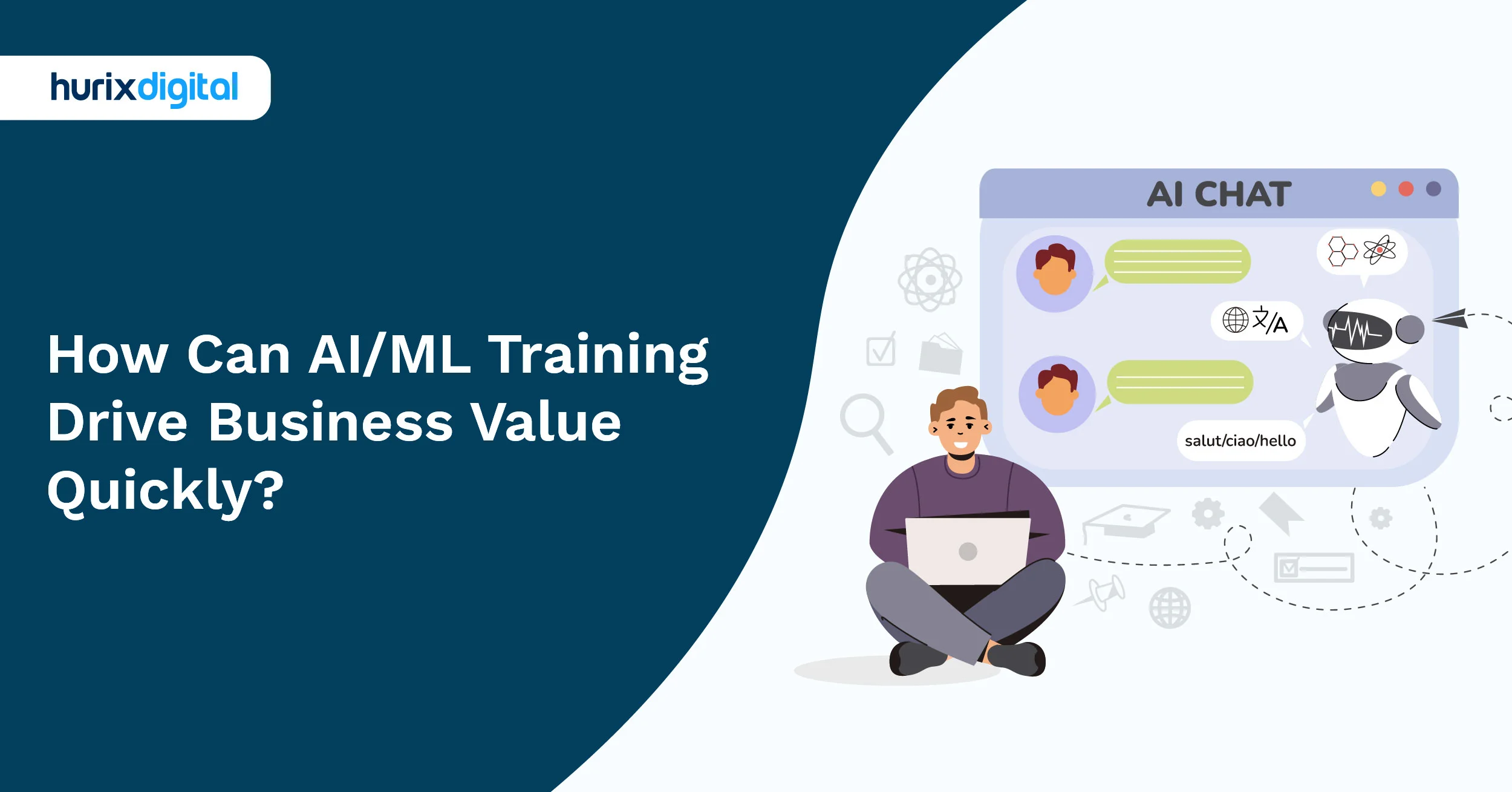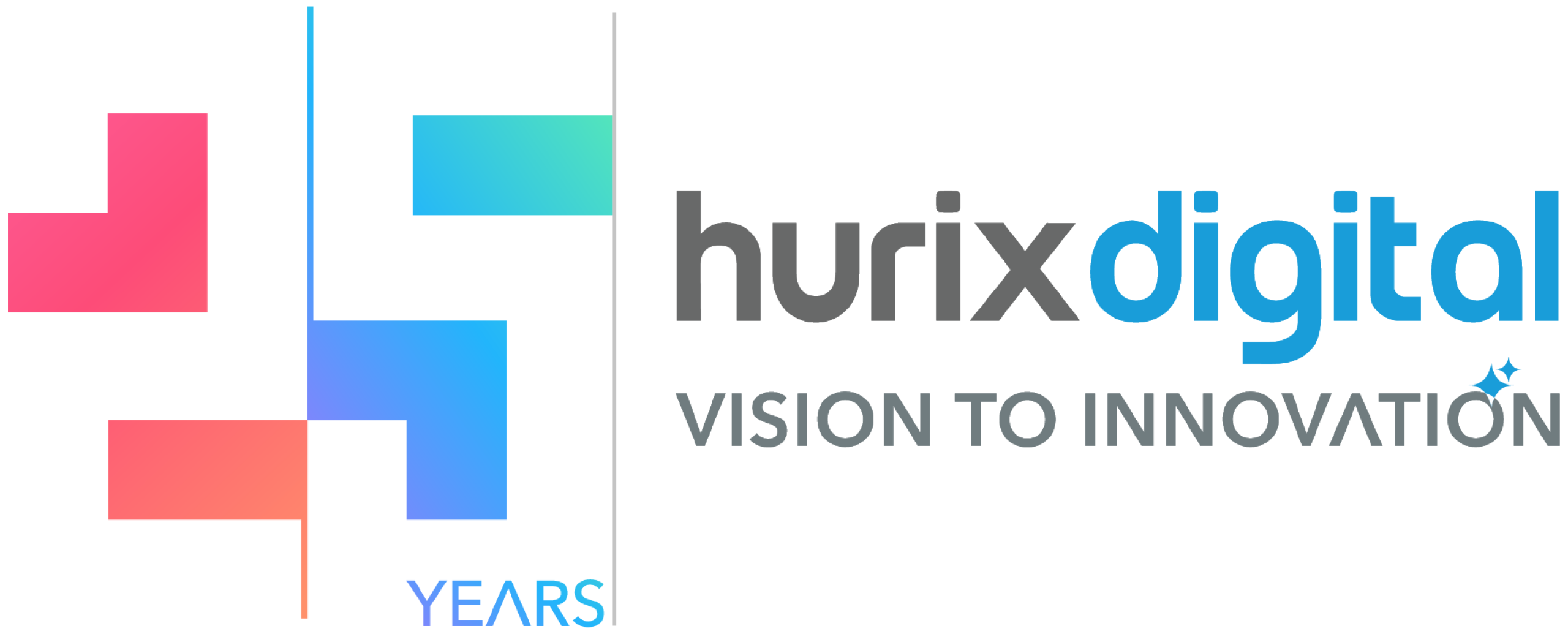
How Can AI/ML Training Drive Business Value Quickly?
Artificial intelligence (AI) and machine learning (ML) can feel like a bag of magic tricks until the first production model drifts, the cloud bill spikes, and the legal team sends a calendar invite with the subject line “urgent.” The truth is calmer than the headlines. Companies achieve reliable gains when they treat AI/ML training as a business discipline, characterized by clear problems, careful data work, repeatable engineering, and steady upskilling. Hurix Digital, as an edtech partner, sits in that trench work—designing AI and ML training courses that map to outcomes leaders already track. That sounds pedestrian, which is the point. Real value rarely looks dramatic. It appears that this approach results in reduced fraud losses, faster underwriting, higher on-time delivery, fewer support tickets, and teams that can clearly explain what the model is doing without speaking in riddles.
If this topic conjures a crowd of buzzwords, park them at the door. What follows is a plain-spoken Q&A drawn from client questions and the literature everyone cites when the conversation turns serious. You’ll see ideas from NIST’s AI Risk Management Framework, a research paper on model documentation and dataset hygiene, and big-picture labor studies on reskilling. Those sources aren’t here for scholarly flair. They’re here because they help executives decide where to spend, when to pause, when to scale, and how to keep auditors, customers, and engineers on the same sheet of music. The goal is simple: build programs that help a generalist manager speak with an ML engineer and both leave the room wiser.
Table of Contents:
- How to Align AI/ML Training with Strategic Business Goals?
- What are the Key ROI Metrics for AI/ML Training Investments?
- How Do We Ensure High-Quality Data for Robust AI/ML Training?
- How to Mitigate the AI/ML Talent Gap Post-Training?
- What Strategies Scale AI/ML Training Across the Enterprise?
- How to Address Ethical AI/ML Model Training Implications?
- What Matters Most When Choosing Optimal AI/ML Training Platforms?
- What Factors Matter Most in Budgeting for Sustainable AI/ML Training Initiatives?
- How Can We Future-Proof Our AI/ML Workforce Skills?
- What Governance Ensures Responsible AI/ML Model Training and Deployment?
- Final Thoughts
How to Align AI/ML Training with Strategic Business Goals?
Start simple. Write down one stubborn business problem per division.
E-commerce faces fake orders, insurance has slow quote replies, retail loses sales from abandoned carts, manufacturing deals with machine breakdowns, and support often misses deadlines. Prioritize these by three easy factors: how valuable, doable, and quick the results are.
McKinsey’s survey work shows that organizations move faster when they pick a few high-potential use cases and attach learning to them, rather than offering generic courses in isolation. In 2024, firms reporting meaningful gains concentrated on targeted applications and built skills programmatically around those use cases.
Then translate each business problem into a short competency map. Fraud example:
- Analysts: feature thinking, sampling basics, ROC/PR curves, segment evaluation.
- Engineers: data pipelines, model registry, deployment checks, monitoring for drift.
- Leaders: ROI framing, risk controls, and change management with frontline teams.
This map becomes your curriculum spine. The NIST AI Risk Management Framework helps here. It forces a lifecycle view with four key steps:
- Govern
- Map
- Measure
- Manage
The framework nudges teams to think ahead. You document context first. You identify risks early. And then you also define success metrics before anyone opens a notebook. It is voluntary guidance, yet widely used because it’s practical and vendor-neutral.
What are the Key ROI Metrics for AI/ML Training Investments?
When people talk about return on investment for AI/ML training, their eyes dart straight to the big, shiny metrics. Faster inference times. Higher accuracy scores. That sort of thing. And sure, those are important for the project itself. But for the training? That’s a whole different animal, a much more subtle beast to track, he thought.
One thing we always pushed for was reducing external dependency. Think about it. Before the training, you may be spending significant money on outside consultants for every new model, or even just for troubleshooting. After a solid training program, does that budget line item shrink? Can your internal team now tackle those challenges, perhaps not perfectly every time, but sufficiently to avoid calling in the cavalry? We have seen companies save hundreds of thousands of dollars a year just by shifting that work in-house. That’s real money, not some abstract improvement.
Then there’s the softer, yet undeniably powerful, metric of employee retention and engagement. People crave growth. When you invest in upskilling them in something as hot as AI/ML, you’re not just giving them tools; you’re telling them they matter, that their future here is bright. I distinctly remember one client once saying, “We spent on training, and suddenly our best engineers stopped looking at LinkedIn.” That’s not a direct financial return, no. But the cost of replacing a skilled AI engineer? It’s astronomical, a true gut punch to any budget. So, preventing that turnover? That’s a massive, often uncalculated, ROI.
How Do We Ensure High-Quality Data for Robust AI/ML Training?
Great models start with boring, well-described tables. Two practices raise the floor quickly:
- Document the data: “Datasheets for Datasets” and “Data Statements” are simple templates that force teams to record origin, collection context, licensing, known gaps, and appropriate use. They emerged from real failures where models underperformed on underrepresented groups. Teams that adopt them catch issues earlier and answer auditors faster.
- Track quality beyond nulls: Treat completeness, accuracy, timeliness, and consistency as separate checks, then automate tests in pipelines. When training and serving don’t match, you get the classic “skew.” Google’s “Rules of ML” and the “Hidden Technical Debt” paper both warn that silent mismatches are where systems rot. Build tests that run every time data moves.
Round out the hygiene with drift watching. Data drift and concept drift degrade a model quietly. You can start with distribution checks and a handful of statistical tests, then add specialized tools as you mature. The definitions are settled: data drift is a change in inputs; concept drift is a change in the input–target relationship. Libraries such as NannyML or Alibi-Detect can help, but the main win is agreeing on alert thresholds and playbooks before things break.
Finally, be mindful of privacy law. If personal data is involved, GDPR’s data minimisation principle says keep information “adequate, relevant and limited to what is necessary,” and HIPAA defines strict rules for health data access and use. Mask, tokenize, aggregate, or synthesize where possible, and document why each field exists. Your future self will thank you.
How to Mitigate the AI/ML Talent Gap Post-Training?
So, your team’s just finished their AI/ML training. Fantastic. That’s the first step, really, but the real test? Keeping those newly sharpened minds engaged, productive, and, frankly, here. It’s a common oversight. People assume the training itself is the solution. It’s not. It’s just the starting gun.
One thing one often observes is a post-training talent drain because folks don’t get meaningful work. Imagine learning to fly a jet, then being asked to just taxi planes around the apron. Frustrating, right? They’ve learned to build models, to see patterns, to think differently. If all they’re doing is cleaning spreadsheets, they’re gone.
Then there’s the isolation. It’s tough to be the only person on a team who understands the intricacies of, say, a transformer architecture. These folks need community. Create spaces beyond formal meetings. Set up a dedicated chat channel where people share discoveries. Try informal “lunch and learns” where they can geek out over new papers. Give them places to vent about tricky datasets. Think of it as a support group for data nerds. I remember an instance where simply dedicating a Friday afternoon to open-ended “AI office hours” completely changed the dynamic of a small team. People started helping each other, not just asking managers for help.
What Strategies Scale AI/ML Training Across the Enterprise?
When you talk about scaling AI/ML training across the enterprise, anyone who’s actually lived through it knows it’s far messier than just buying more GPUs. For him, one of the biggest, often-overlooked strategies is standardizing the MLOps workflow. Think about it: if every team is rolling their own experiment tracking, their own version control for models, their own way to push code to production, you’re not just inefficient; you’re building isolated islands.
Then, there’s the inevitable compute resource battle. In a big organization, GPUs become gold dust. Teams hoard clusters, booking machines for days, only to have them sit idle for half that time. Having centralized, intelligent compute management here isn’t just a nice-to-have; it’s essential.
A system that understands priorities can spin up resources for a critical daily retraining job and then automatically release them back into the pool for someone else’s exploratory work. We have seen companies spend millions on hardware, only to realize much of it was underutilized because their internal “traffic control” for compute was nonexistent. Without it, you’re just buying expensive space heaters. Make sure your horsepower is put to work as efficiently and fairly as possible across the entire organization.
How to Address Ethical AI/ML Model Training Implications?
Fairness and transparency are not adornments. They are how you avoid harm and reduce regulatory risk. A few anchors are as follows:
- Bias is measurable: “Gender Shades” demonstrated sharp error disparities in commercial facial analysis, especially for darker-skinned women. The point is not to debate one domain, but to internalize the lesson: if your data under-represents a group, performance there will lag unless you correct for it and document limits.
- Document intent and limits: Model cards ask you to declare intended use, evaluation conditions across groups, and known failure modes. Datasheets ask you to disclose how a dataset was built and where it breaks. These are low-cost habits with high downstream value.
- Adopt a risk framework: NIST’s AI RMF gives an actionable structure: Map context and risks, Measure them, Manage through controls, and Govern across the lifecycle. ISO/IEC 42001 now adds a management-system standard organizations can certify against, aligning with that lifecycle view.
- Privacy by design: GDPR’s data minimisation principle and sector rules, such as HIPAA, demand restraint and strong access control. If the work touches health or financial data, bring privacy engineering into day one of the project.
If you operate in Europe or sell there, expect the EU AI Act to harden obligations for high-risk systems, with transparency and documentation front and center. Exact compliance dates vary and implementation details continue to evolve, but the risk-tier approach is now set. Plan accordingly.
What Matters Most When Choosing Optimal AI/ML Training Platforms?
Start with brutal honesty about capabilities and requirements. Many organizations choose platforms based on aspirational use cases they’ll never implement. Meanwhile, they struggle with basic requirements that their current tools could handle if properly configured. A manufacturing client spent months evaluating cutting-edge platforms before realizing their immediate need was simple anomaly detection that their existing tools supported.
Integration capabilities matter more than features. The fanciest platform becomes shelfware if it can’t connect to your data sources, deploy to your infrastructure, or integrate with your workflows. Real integration goes beyond APIs. Can your data scientists use familiar tools? Can models deploy to your production environment? And can business users access results through existing interfaces? The best platform is the one people actually use.
Support quality becomes obvious during a crisis. When model training fails at 3 AM before a critical deadline, response time matters. But support quality goes beyond speed. Do support engineers understand your use cases? Can they provide architectural guidance, not just troubleshooting? Rather than feeling like a ticketing system, the best vendors feel like partners.
What Factors Matter Most in Budgeting for Sustainable AI/ML Training Initiatives?
Sustainable AI/ML training requires a balanced budget addressing multiple critical dimensions. Allocating resources wisely across skills development, data quality, infrastructure, governance, and change management creates lasting value and reduces risks. Consider these key budget categories:
- Skills program (20–30%): Cohort-based learning with capstone artifacts tied to live use cases. Include beginner paths for product and risk teams and deeper labs for engineers.
- Data work (25–35%): Labeling, enrichment, quality monitoring, and documentation. Skimp here and you will “pay interest” later in maintenance and reputational risk. The technical-debt literature in ML is blunt on this point.
- Platforms and infra (20–30%): Training environments, experiment tracking, registry, pipelines, and monitoring. The exact split depends on how much you buy versus build and how much is already in the cloud.
- Governance and privacy (10–15%): Risk assessments, legal reviews, red-team exercises, and periodic audits against AI RMF or ISO/IEC 42001.
- Change management (5–10%): Communication, internal marketing, and time for managers to coach teams.
For cloud cost control, borrow from FinOps playbooks: right-size instances, schedule compute windows, use spot or reserved capacity when appropriate, and set budget alerts with human owners. Even simple measures prevent bill shock during model development.
How Can We Future-Proof Our AI/ML Workforce Skills?
The half-life of AI/ML skills might be the shortest in tech. Frameworks that dominated two years ago are already legacy. Last year’s cutting-edge techniques are now considered standard.
Traditional training approaches fail spectacularly. By the time you develop a curriculum, get it approved, and deliver training, the content is outdated. Sending people to conferences helps, but doesn’t scale. Online courses provide foundations but may miss practical applications. In order to achieve learning objectives, multiple channels must be combined.
The depth-versus-breadth dilemma requires thoughtful navigation. Should team members specialize deeply in specific areas or maintain broad capabilities? The answer depends on team size and organizational needs. Large teams can afford specialists, while smaller teams need generalists. However, everyone needs a foundational understanding of core concepts and emerging trends.
External partnerships accelerate capability building. Collaborating with universities brings fresh perspectives and early access to research. Working with vendors like Hurix Digital provides practical insights into tool evolution. Participating in open-source communities keeps teams connected to broader developments.
What Governance Ensures Responsible AI/ML Model Training and Deployment?
Effective governance starts with clear roles and responsibilities. Who approves model deployment? Who monitors performance? And who decides when retraining is necessary? These questions seem basic until you’re in a crisis. After partnering with us, one automotive company discovered nobody had clear authority to shut down a malfunctioning model affecting production. The confusion cost them millions before they sorted out decision rights.
Documentation requirements balance thoroughness with practicality. Nobody reads 100-page model documentation. But single-page summaries miss critical details. The solution is tiered documentation: executive summaries for leadership, technical details for practitioners, and audit trails for compliance. Each audience gets what they need without drowning in irrelevant information.
Risk assessment frameworks must evolve beyond traditional approaches. IT risk frameworks focus on system availability and data security. AI/ML risks include model drift, bias amplification, and adversarial attacks. A loan approval model that works perfectly in testing might discriminate when deployed. A chatbot trained on clean data might generate offensive responses when facing real users. These risks require new assessment methods and mitigation strategies.
Final Thoughts
The journey through AI/ML training challenges reveals a consistent theme: success requires striking a balance between technical excellence and organizational realities. Surprisingly, the companies thriving in this space often lack the biggest budgets or smartest people. Instead, they excel at execution and quickly learn from mistakes. They’re the ones who figure out how to align technology with strategy, manage talent thoughtfully, and govern responsibly while maintaining agility.
As AI/ML continues evolving at breakneck speed, the one certainty is continued uncertainty. New techniques will emerge. Current approaches will become obsolete. Regulations will shift. Processes, people, and partners that are built on solid foundations will adapt more quickly than those that chase every new trend.
Partner with Hurix.ai for expert data annotation and AI/ML data labeling solutions that empower your projects with accuracy and efficiency. Reach out today to elevate your AI initiatives with the right support.

Vice President – Content Transformation at HurixDigital, based in Chennai. With nearly 20 years in digital content, he leads large-scale transformation and accessibility initiatives. A frequent presenter (e.g., London Book Fair 2025), Gokulnath drives AI-powered publishing solutions and inclusive content strategies for global clients
 Upcoming Masterclass | Build an Army of Brand Evangelists using Training & Development | November 20th, 8:30 AM PDT | 11:30 AM EDT | 10:00 PM IST
Upcoming Masterclass | Build an Army of Brand Evangelists using Training & Development | November 20th, 8:30 AM PDT | 11:30 AM EDT | 10:00 PM IST
